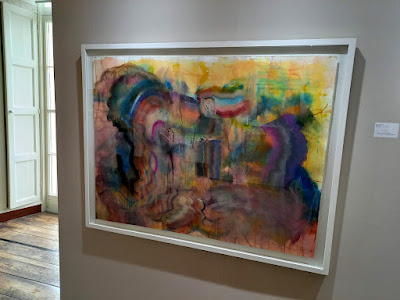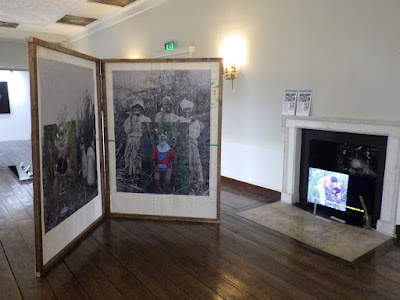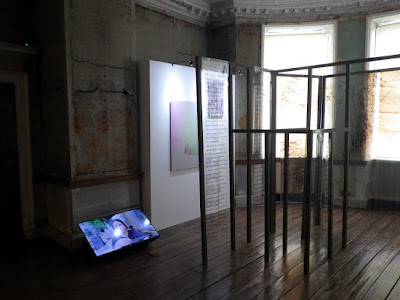From Aug 14 to Sept 26 an exhibition of recent work by Diana Copperwhite is (or was, depending on when you might be reading this!) at Rathfarnham Castle. After seeing an artist talk (part of a weekly series from Graphic Studio Dublin during lockdown) where Copperwhite presented her art practice, I was curious to see her work in the flesh. As with the other GSD artist talks, recordings can be seen on YouTube (GSD has its own channel); the recording of Diana Copperwhite's presentation can be viewed here. Because of Covid protocols, it is a good idea to ring Rathfarnham Castle in advance to let them know when you wish to see the exhibition. There is easy signage to direct you in viewing the exhibition though there was no one else there when I attended. Although I could see work near the bay windows of the large Dining Room I followed the floor arrow through the door to the long Saloon where most of Copperwhite's work was displayed. Her work draws the viewer in because of its intense colour. I was surprised to find that the large curtain was not a draping painting, but actually an industrial print of a painting onto a large curtain!
Musings about art, writing, music, travel and food (life, the universe & everything...) by Lorraine Whelan
Wednesday, 25 August 2021
Diana Copperwhite at Rathfarnham Castle
Wednesday, 18 August 2021
Knockeen - finished painting!
I think it was the first week of August that I declared (to myself) that Knockeen was finished and I signed it without further ado. It is a painting that I have been working on for most of this year and I blogged progress reports fairly regularly; you can see the painting's development here, here, here and here.
Wednesday, 11 August 2021
Bite The Hand That Feeds You
A few weeks ago I went to Rathfarnham Castle to see the PhotoIreland Festival group exhibition Bite The Hand That Feeds You. In that very large space I was delighted to see that the exhibition was a smaller group show than I expected, where each artist was given ample room to stage individual installations of work around this year's themes (food consumption & human-animal relationships being the bigger ones). The first installation that one comes across (due to Covid the system of masked movement is, understandably, very particular) is by Finnish artist Hertta Kiiski. Milky Way consists of goods (cloth and clothing) that reference her video (not in the picture below) of two very bored looking teens, dressed alike and cradling large, oddly-shaped, clear bottles of milk, which they periodically drank from. There was no dialogue in the video (at least while I was watching) and the ennui was infectious, so I did not stay for the duration. I definitely had the sense of teen insecurity (in the way the bottles were cradled), boredom, and the ability to consume as something to be taken for granted. I assumed this was cow's milk as opposed to human milk and it highlights that, perhaps somewhat dubious, human-animal relationship where human's are the beneficiaries of an animal product.
*This explanation of "Joly photographs" was written on a didactic at the exhibition: This is a method of colour photography developed in the 1890s by John Joly, a physics professor at Trinity College, Dublin. It is an additive colour method, with a striped red, green and blue (RGB) colour screen placed in front of the film in-camera on exposure and then again on display. Colour information is recorded on black and white film and rendered as a colour image when the screen and film are put together. The film is processed as a positive and so what is displayed is the film that was in the camera, not a print or reproduction.































